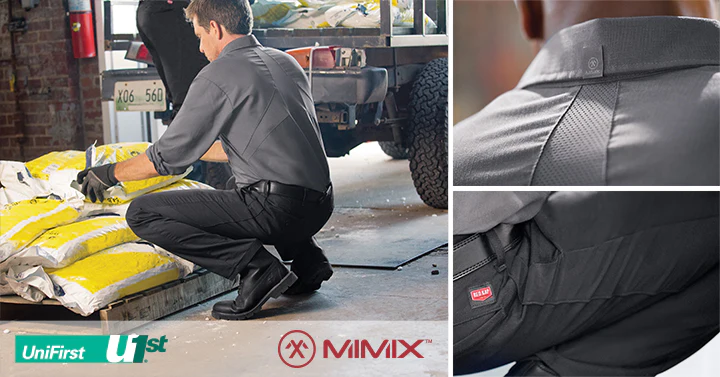Uniform fabrics have come a long way and uniform suppliers, such as UniFirst, continue to offer the most advanced fabrics that meet customer needs for comfort and performance.
During the first half of the 20th century, through the 1950s, workers had virtually no choice when it came to the fabrics used in their uniform clothing. It was 100% cotton work shirts and pants or nothing. And while cotton was generally considered comfortable, it was not very durable; wrinkled easily, soiled quickly, and dried slowly when wet.
If there was a period in the textile services industry we could point to as the turning point for fabric choices it would be the 1960s when the uniform supply industry moved toward adopting man-made fibers for fabrics to improve overall comfort and functionality in work shirts and work pants.
During the rebellious 1960s consumers demanded more comfort from their personal clothing. This decade would mark the beginning of an ongoing commercial revolution in fabrics—many of which would weave their way into the uniforms worn by workers everywhere.
Select Uniforms for Breathability and Durability
Consumer demand for improved fabrics during this time dovetailed with research efforts made during previous decades, when chemists experimented with plant cellulose, petrochemicals, and even specialized alcohols to synthesize filaments in test tubes. It was hoped that resulting new fibers could create fabrics to rival cotton for softness, and outperform it with respect to breathability (comfort) and durability. These early research efforts set the stage for a shift away from workwear made of 100 percent cotton.
Two of the first artificial fibers to emerge for commercial textile use were rayon and nylon, which were made from plant cellulose and petrochemicals, respectively. Both were touted for their strength and abrasion resistance, which made them attractive to workers in high-soil industries. Cotton was still king, but this was when uniform providers began incorporating nylon outerwear, specifically jackets and pants, into their offerings.
Polyester, the Miracle Fabric
During the 1970s, as workers became increasingly accustomed to synthetic clothing, they demanded even more comfort in work shirts and work pants. As a result, apparel manufacturers responded with a new “miracle fabric” called polyester. Polyester fabric is made from petroleum-based products and had been available since the 1940s. But it was now becoming widely embraced by clothing manufacturers to provide customers with apparel that was not only comfortable and durable, but had revolutionary “wash-and-wear” characteristics and “wrinkle-free” convenience. Polyester fashions would become omnipresent during the 1970s (particularly on the disco-era dance floors).
Such wholesale demand for polyester fabrics led leading uniform suppliers like UniFirst to begin offering uniform shirts and pants using polyester/cotton blends. The combination of the two fabrics provided workers with the best of both worlds—apparel that was breathable and comfortable yet durable and resistant to wrinkles and stains.
Advances in Polyester Workwear
However, early polyester could be uncomfortably hot to wear for lengthy periods of time. That shortcoming challenged researchers who, during the 1980s, began to investigate spun polyester for commercial use. Spun polyester threads are made by spinning or twisting together shorter lengths of polyester fibers—similar to the way cotton threads are made. As a result, spun polyester threads look and feel more like cotton, but provide superior strength, moisture wicking, and durability. Spun poly proved a success with retail consumers throughout the 1980s, and the textile industry widely embraced it during the 1990s-2000s—particularly in more casual workwear, such as polo shirts, which were sought after by businesses focused on corporate image.
During the 1990s, the athletic-wear industry sprinted to the forefront of the fabric innovation race by introducing popular lines of “performance apparel.” Following close on their heels were a number of progressive work-apparel manufacturers who began introducing uniform clothing made from “microfibers”—polyester fibers that are 1/100 the diameter of a human hair. Besides being soft and durable, microfiber excelled at wicking moisture away from the body to keep wearers cool and dry.
Today, a wide range of synthetic fabrics can be found in all types of work apparel, from corporate casual wear to the most demanding industrial settings (where poly/cotton blends continue to be a favorite).
Choosing the Right Fabric for Work Uniforms is Key for Comfort, Performance, and Style
UniFirst offers a large selection of work shirts, work pants, and more in hundreds of styles, colors, and fabric options. But the 65/35 poly/cotton combination is still the most popular because of its versatility to meet the needs of so many industries, as well as its overall comfort, function, ease-of-care, and price point.
One of the most cutting-edge uniform solutions to date, the MIMIX™ line of workwear, is engineered to mimic the way a person moves when they’re performing on-the-job tasks to provide maximum mobility, along with the ultimate in comfort and durability. Unlike ordinary stretch-fabric garments, MIMIX work shirts and work pants feature strategically placed, science-backed, built-in flex panels that provide increased mobility and a comfortable fit where workers need it most. This allows wearers to bend, squat, and stretch all day long without anything holding them back.
Uniform fabrics have come a long way and uniform suppliers, such as UniFirst, continue to offer the most advanced fabrics that meet customer needs for comfort and performance. For more information about UniFirst uniform programs, visit our Uniform Rental Service Programs page or contact UniFirst today

